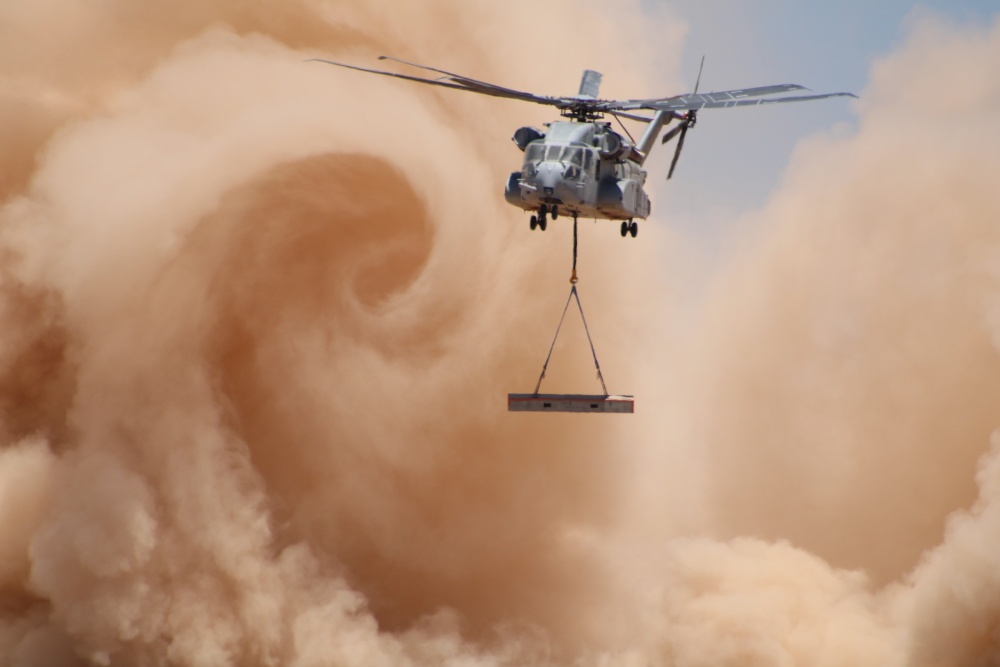By Mark Schauer
YUMA PROVING GROUND, Ariz.– The CH-53 has been a potent member of the Marine Corps aviation community’s fleet for over 40 years, but the newest version takes the platform to a whole new level.
Equipped with three 7,500 horsepower engines and built to carry a nearly 30,000 pound external load for over 100 miles, the CH 53K King Stallion boasts a 20% increase in heavy lift capability over its predecessors.
The most impressive new feature, though, is fly-by-wire technology that computerizes flight controls and represents a major advancement over hydraulic ones. In addition to making the craft lighter, the new controls assist pilots, particularly in degraded visual environments.
The CH-53K has undergone extensive developmental testing that utilized the degraded visual environment (DVE) test course at U.S. Army Yuma Proving Ground (YPG) for more than two years, most recently to verify software updates in the flight control software that have been made as a result of this testing.
“This iteration of testing is somewhat of a culmination exercise for the team,” said Joshua Magana, test officer. “After this, the program will go into an initial operation test and evaluation training period that will train the pilots, air crew, and maintainers who support will support the initial operational testing next spring.”
YPG’s DVE course is highly coveted by helicopter testers seeking to protect flight crews from the potentially catastrophic consequences of brownouts. Caused by rapidly blowing sand and dirt thrown into a vortex by the rotor blades of a helicopter, a brownout’s swirling dust gives pilots the illusion they are moving even if they are hovering stationary. Hazardous in any situation, it is particularly risky when landing in a combat zone with multiple other aircraft, or in a situation where support personnel are on the ground below. The risk is compounded when the aircraft is hauling an extremely heavy cargo load beneath it.
The extremely fine ‘moon dust’ on YPG’s DVE course, tilled for maximum diffusion when a helicopter hovers overhead, was more than adequately harsh for the testers’ purposes—YPG personnel prepared the site in such a way to ensure a variety of DVE conditions, disking the dusty ground at depths of two and eight inches while leaving other areas of the site completely untilled.
“If they flew at one end of the course, it was as bad a DVE as it can possibly get,” said Magana. “If they flew on the other end, it was significantly less severe.”
The King Stallion’s primary mission is Assault Support, and testers put it through its paces at the DVE in extremely realistic scenarios that included support from Marine Wing Support Squadron 371 based at Marine Corps Air Station-Yuma. The Marines attached and unhooked massive blocks of standardized weights ranging between six and 13.5 tons as the CH-53K traversed the DVE course, day and night.
“It’s meant to simulate everything from a Joint Light Tactical Vehicle to a Light Armored Vehicle,” said Magana. “The aircraft is made to carry externally anything up to 36,000 pounds, unhook it, and get out of there.”
Aircraft refueling at YPG typically is only done ‘cold,’ or with the aircraft’s engines off and powered down, as a safety measure. To maintain maximum realism for test purposes and increase the efficiency of the test, however, a waiver was granted to allow for ‘hot’ refueling of the aircraft as it was put through its paces. MWSS 371 established a Forward Arming and Refueling Point (FARP) on an improved airstrip close to the DVE site.
“The customer wanted on-site hot refueling because using an operationally representative FARP was a test point,” said Magana.
MWSS 371 successfully treated the ground beneath the FARP with dust abatement material: As the CH-53K is a developmental aircraft, they wanted to minimize the risk of foreign objects and debris being vertically propelled into the aircraft and damaging it. The weight blocks used in the testing were also staged here.
“The testers received test efficiency, and MWSS 371 received training on refueling this new aircraft in an operationally realistic environment,” said Magana. “It was a win-win that integrated training with our developmental test.”
Remarkably, the large scale test that began its planning phase in early 2020 proceeded without delay despite the arrival of the COVID-19 pandemic a mere weeks after formal coordination began.
“The program’s schedule didn’t slip at all,” said Magana. “The customer had implemented strict COVID-19 procedures for their personnel prior to coming here and after arriving, and followed all of YPG’s procedures once they were here.”
This article was published by DVIDS on September 9, 2020.
For our report on the CH-53K, see the following:


